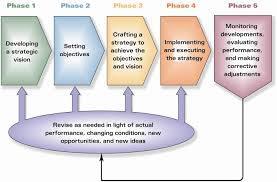Fechar


STRATEGIC VISION...
Describes the route the company intends to take in developing and strengthening its business.
Thinking about changes in a company's product, market, customer or technology to improve current market position and future prospects.
Communicates managers vision to stakeholders.
PHASE 2: SETTING OBJECTIVES...
Purpose of setting objectives is to convert the strategic vision into specific performance targets.
Results and outcomes management wants to achieve.
Objectives represent a managerial commitment to achieving particular results and outcomes.
"You cannot manage what you cannot measure"- BILL HEWLETT.
A company that meets/beats its objectives is generally a better overall performer than a company who doesn't.
Spells out how much of what kind of performance and by when.
BALANCED SCORECARD- Financial Performance and Strategic Performance.
EG; x% increase in annual revenues
Annual increases in earnings per share.
Winning x% market share.
Achieving low overall costs than rivals.
Better product selection than rivals.
Achieving technological leadership.
SHORT-TERM OBJECTIVES...
Targets to be achieved soon.
Milestones for reaching long-range performance.
Can be achieved within the next 6 months - 1 year.
PHASE 3: CRAFTING A STRATEGY...
Entails answering a series of "how's".
How to grow the business, how to please customers, how to achieve financial and strategic objectives, how to out-compete rivals and how to respond to changing market conditions.
Proactively searching for opportunities to do new things/ do existing things better.
Must pay attention to early warnings of future change.
Must out-innovate competitors, be more imaginative and adapt faster.
PHASE 4: IMPLEMENTING and EXECUTING THE STRATEGY...
Operations-orientated activity aimed at performing core business activities.
Most demanding and time-consuming part of this process.
Tests a managers ability to direct organizational change, motivate people, create and nurture a strategy-supportive work climate.
Execute the strategy competently.
Achieve the targeted financial and strategic performance.
"How much internal change is needed?"
Ensuring staff has needed skills and expertise to implement effectively.
PHASE 5: EVALUATING PERFORMANCE AND MAKING CORRECTIVE ADJUSTMENTS...
Monitoring new external developments.
Evaluating company's performance.
Making necessary adjustments.
Deciding whether to continue or change the company's vision, objectives, strategy, etc.
So long as strategy is well-matched, performance targets are being met, company may stay on course.
But whenever it may encounter disruptive changes in its environment, questions needs to be raised if change is needed.
It is to be expected the strategy will be modified over time.

 Ocultar acertos
Ocultar acertos